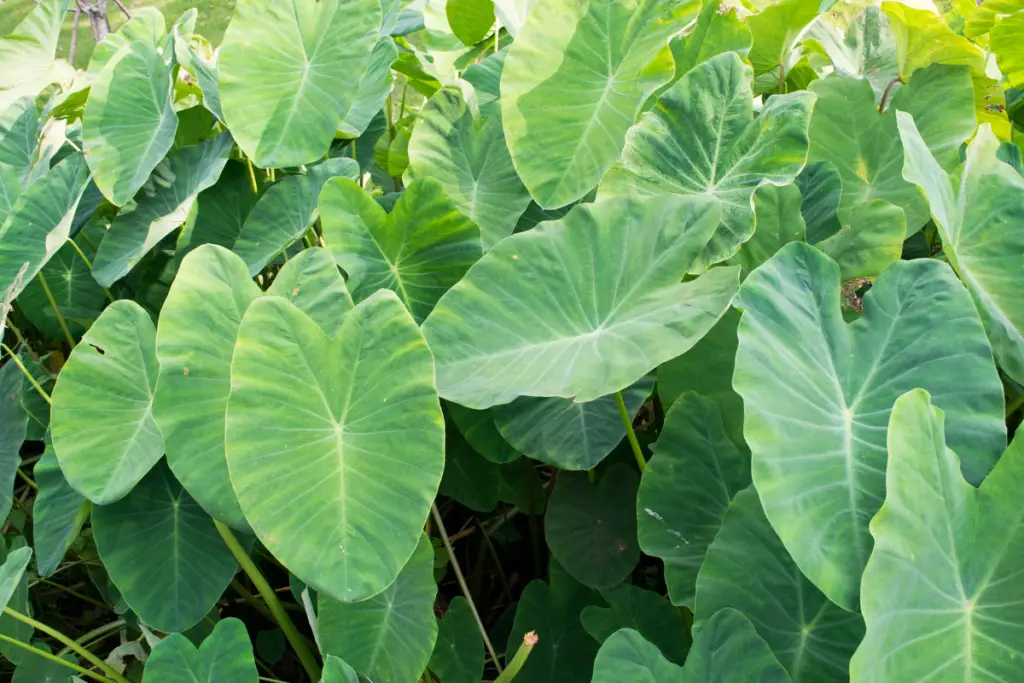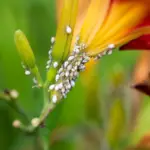Elephant Ear plants are a popular ornamental plant grown for their large, lush foliage that resembles an elephant’s ear.
While these plants are aesthetically pleasing, they also contain a toxic sap that can cause harm to humans and animals.
The toxicity of Elephant Ear sap, stems, leaves, and tubers is a topic of concern and has been the subject of much discussion in the gardening and horticultural communities.
According to Plant Care Today, it is generally safest to assume that all parts of plants nick-named Elephant Ear are toxic because, in most cases, they are.
Eating these parts can cause excessive drooling and mouth irritation. Ingesting large quantities of the plant can cause swelling of the tongue and throat, leading to difficulty breathing.
In some cases, ingesting Elephant Ear can be fatal. Therefore, it is essential to be aware of the potential dangers associated with these plants and take necessary precautions to prevent accidental ingestion.

Table of Contents
Elephant Ear Plant Overview
The Elephant Ear Plant, also known as Colocasia esculenta, is a tropical plant with large, heart-shaped leaves that can grow up to 3 feet long and 2 feet wide.
It is native to Southeast Asia and is commonly used as an ornamental plant in gardens and landscapes due to its unique appearance.
The plant is also known for its starchy corms, which are used as a food source in many cultures. In addition, the leaves of the Elephant Ear Plant are used for wrapping food, such as tamales.
While the Elephant Ear Plant is a popular choice for gardeners and food enthusiasts, it is important to note that all parts of the plant are considered toxic.
The plant contains calcium oxalate crystals, which can cause irritation and swelling in the mouth, throat, and digestive tract if ingested.
Contact with the plant can also cause skin irritation in some individuals. Symptoms may include redness, itching, and swelling.
It is important to handle the Elephant Ear Plant with care and to keep it out of reach of children and pets. If ingested or if skin contact occurs, seek medical attention immediately.
Understanding Plant Sap
Plant sap is the liquid that circulates through the plant’s vascular system. It is a vital component of the plant’s life, as it transports water and nutrients from the roots to the rest of the plant.
The sap of a plant can vary in color, texture, and composition depending on the plant species.
Some plants, such as the elephant ear plant, produce a milky sap that can be toxic to humans and animals.
The toxic properties of plant sap are due to the presence of chemical compounds such as saponins, alkaloids, and glycosides.
These compounds can cause skin irritation, blistering, and even death in some cases.
It is essential to handle plants with toxic sap carefully. Avoid touching the sap with bare skin, and wear gloves and protective clothing when working with these plants.
If sap comes into contact with the skin, wash the affected area with soap and water immediately.
Ingesting plant sap can be dangerous, especially in large quantities. Symptoms may include nausea, vomiting, diarrhea, and abdominal pain.
In severe cases, ingesting toxic sap can cause respiratory failure, seizures, and even death.
It is crucial to be aware of the potential dangers of plant sap, especially when handling toxic plants such as the elephant ear plant.
By taking the necessary precautions, you can enjoy the beauty of these plants without putting yourself or others at risk.
Is Elephant Ear Sap Poisonous?
Elephant ear plants, also known as Alocasia, Colocasia, or taro, are popular ornamental plants because of their large, attractive heart-shaped leaves.
However, the sap of elephant ear plants contains asparagine, calcium oxalate, and saponins, which are toxic to humans and other mammals.
Consumption of elephant ear plants or their sap can lead to serious health problems, including nausea, vomiting, diarrhea, and in severe cases, difficulty breathing and even death.
Therefore, it is important to take necessary precautions when handling these plants.
It is recommended to wear gloves and protective clothing when handling elephant ear plants to avoid skin irritation and accidental ingestion of the sap.
In case of accidental ingestion or exposure to the sap, it is advised to seek medical attention immediately.
While elephant ear plants are toxic, it is important to note that not all parts of the plant are equally poisonous.
The leaves and stems contain the highest concentration of toxins, while the tubers, which are commonly consumed in many parts of the world, contain lower levels of toxins and can be prepared and consumed safely.
Overall, it is important to exercise caution and take necessary precautions when handling elephant ear plants or their sap to avoid potential health risks.
Effects of Elephant Ear Sap on Humans
Skin Irritation
Elephant Ear Sap can cause skin irritation in humans. The sap contains calcium oxalate crystals, which can cause a burning sensation, rash, and blisters on the skin.
The severity of the reaction can vary depending on the amount of sap that comes into contact with the skin and the sensitivity of the individual.
It is recommended to avoid direct contact with the sap and to wear gloves and protective clothing when handling the plant.
Eye Irritation
Contact with Elephant Ear Sap can also cause eye irritation. If sap gets into the eyes, it can cause redness, pain, and swelling.
It is important to flush the eyes with water immediately and seek medical attention if the irritation persists.
Ingestion Effects
Ingesting Elephant Ear Sap can cause more severe symptoms. The sap contains calcium oxalate crystals, which can cause irritation and swelling in the mouth, tongue, and throat.
This can lead to difficulty breathing, swallowing, and speaking. Ingestion can also cause stomach pain, vomiting, and diarrhea. If ingested, seek medical attention immediately.
It is important to note that all parts of the Elephant Ear plant are considered toxic and should be kept away from children and pets.
If you suspect that someone has ingested any part of the plant, call your local poison control center or the national poison control hotline at 1-800-222-1222.
Effects of Elephant Ear Sap on Pets
Elephant Ear plants are known for their large, heart-shaped leaves that can grow up to 3 feet long. While they are a beautiful addition to any garden, they are also toxic to pets and humans.
The sap of the Elephant Ear plant contains calcium oxalate crystals, which can cause a range of symptoms in pets if ingested.
Effects on Dogs
If a dog ingests the sap of an Elephant Ear plant, they may experience oral irritation, intense burning and irritation of the mouth, lips, and tongue, excessive drooling, vomiting, difficulty in swallowing, and a swollen airway leading to inability to breathe. In severe cases, this can lead to death.
Effects on Cats
Cats are also at risk if they come into contact with the sap of an Elephant Ear plant. They may experience oral irritation, excessive drooling, vomiting, difficulty in swallowing, and a swollen airway leading to inability to breathe. In severe cases, this can lead to death.
It is important to note that not all pets will have the same reaction to the sap of an Elephant Ear plant.
Some pets may have a more severe reaction than others, and the severity of the reaction can depend on the amount of sap ingested.
If a pet has ingested the sap of an Elephant Ear plant, it is important to seek veterinary care immediately.
The veterinarian may induce vomiting, administer activated charcoal to absorb any remaining toxins in the stomach, and provide supportive care to manage symptoms.
In conclusion, the sap of the Elephant Ear plant is toxic to pets and can cause a range of symptoms if ingested.
Pet owners should take caution when planting these plants in their garden and ensure that their pets are kept away from them. If a pet does come into contact with the sap, seek veterinary care immediately.
Precautions When Handling Elephant Ear Plants
Elephant Ear plants are known for their large, arrow-shaped leaves that can grow up to 6 feet tall.
While these plants can add a stunning tropical look to any garden or home, it is important to be aware of their potential toxicity.
All parts of the plant, including the sap, flowers, and seeds, are potentially toxic to humans and animals.
If you are planning to handle Elephant Ear plants, it is important to take precautions to avoid any potential harm.
Here are some tips to keep in mind:
- Wear gloves: When handling Elephant Ear plants, it is recommended to wear gloves to avoid any skin irritation or allergic reaction. The sap of the plant can cause skin irritation, and in some cases, it can cause blisters or burns.
- Wash hands thoroughly: After handling Elephant Ear plants, it is important to wash your hands thoroughly with soap and water. This will help to remove any sap or residue that may have come into contact with your skin.
- Avoid ingestion: Elephant Ear plants are poisonous if ingested, and can cause symptoms such as nausea, vomiting, and diarrhea. It is important to keep these plants out of reach of children and pets, and to avoid ingesting any part of the plant.
- Seek medical attention: If you or someone you know has ingested any part of an Elephant Ear plant, it is important to seek medical attention immediately. Symptoms of poisoning can include swelling of the tongue, mouth, and eyes, and blistering and swelling in the mouth that may prevent normal speaking and swallowing.
By following these precautions, you can safely handle Elephant Ear plants and enjoy their stunning beauty without any harm to yourself or others.
Treatment for Elephant Ear Sap Exposure
If someone comes into contact with elephant ear sap, it is important to take the appropriate steps to avoid any adverse effects.
Here are some tips for treating elephant ear sap exposure:
- Wash the area thoroughly: If the sap comes into contact with the skin, wash the affected area with soap and warm water. This will help to remove any remaining sap and reduce the risk of irritation.
- Apply a topical treatment: Over-the-counter treatments for other irritating plants, such as poison ivy, often work well for treatment of mild skin irritation from exposure to elephant ear plant parts. According to the National Eczema Association, topical analgesics, moisturizing creams, and lotions can provide temporary relief from contact dermatitis symptoms.
- Seek medical attention if necessary: In severe cases, exposure to elephant ear sap can cause more serious symptoms, such as difficulty breathing or swallowing. If someone experiences these symptoms, seek medical attention immediately.
It is also important to note that ingestion of elephant ear sap can be toxic and potentially fatal.
If someone ingests elephant ear sap, call the local emergency number (such as 911), or the local poison control center can be reached directly by calling the national toll-free Poison Help hotline (1-800-222-1222) from anywhere in the United States.
Poison control experts will provide advice on what to do next.
Conclusion
In conclusion, Elephant Ear plants are generally considered to be poisonous due to the presence of calcium oxalate crystals in all parts of the plant.
These crystals can cause irritation and swelling if they come into contact with skin, and can be especially harmful if ingested.
While some people in certain parts of the world consume the tubers and leaves of certain Elephant Ear plants, it is generally safest to assume that all parts of the plant are toxic.
It is important to exercise caution when handling these plants, especially when pruning or repotting them.
If someone comes into contact with Elephant Ear sap or ingests any part of the plant, they should seek medical attention immediately.
Symptoms of Elephant Ear poisoning can include burning and swelling of the mouth and throat, difficulty breathing, and in severe cases, convulsions and even death.
Overall, it is important to be aware of the potential dangers associated with Elephant Ear plants, and to take appropriate precautions when handling or growing them.
By following basic safety guidelines and being mindful of the risks, gardeners and plant enthusiasts can continue to enjoy the beauty and unique characteristics of these fascinating plants.
- How to Dry Basil Leaves: A Professional Guide
- Is an Avocado a Fruit or Vegetable? Simple Answer and Explanation
- Does Pineapple Have Seeds? Exploring the Anatomy of Pineapples
- Blooming Through Winter: Can I Grow Vegetables Indoors in the Winter?
- What Can You Grow in a Greenhouse All Year Round: A Guide to Year-Round Greenhouse Gardening
- Are Blueberries Blue? Debunking the Myth of Their Color
















